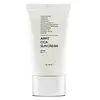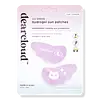What's inside
What's inside
 Key Ingredients
Key Ingredients

 Benefits
Benefits

 Concerns
Concerns

 Ingredients Side-by-side
Ingredients Side-by-side

Water
Skin ConditioningEthylhexyl Methoxycinnamate
UV AbsorberHomosalate
Skin ConditioningEthylhexyl Salicylate
UV AbsorberButyloctyl Salicylate
Skin ConditioningDiethylamino Hydroxybenzoyl Hexyl Benzoate
UV FilterDibutyl Adipate
EmollientAlcohol
AntimicrobialBis-Ethylhexyloxyphenol Methoxyphenyl Triazine
Skin ConditioningPropanediol
SolventCaprylyl Methicone
Skin ConditioningGlycerin
HumectantNiacinamide
SmoothingPentylene Glycol
Skin ConditioningPolysilicone-15
UV FilterChlorella Vulgaris Extract
Skin ConditioningPortulaca Oleracea Extract
Skin ConditioningMelaleuca Alternifolia Leaf Oil
AntioxidantCentella Asiatica Leaf Extract
Skin ConditioningPanax Ginseng Root Extract
EmollientUlmus Davidiana Root Extract
Skin ConditioningGold
Cosmetic ColorantCamellia Sinensis Leaf Extract
AntimicrobialGlycyrrhiza Glabra Root Extract
BleachingChamomilla Recutita Extract
Skin ConditioningRosmarinus Officinalis Leaf Extract
AntimicrobialHydrolyzed Pea Protein
EmollientOlea Europaea Fruit Oil
MaskingButyrospermum Parkii Butter
Skin ConditioningPolymethylsilsesquioxane
Glyceryl Stearate
EmollientPEG-100 Stearate
Acrylates/C10-30 Alkyl Acrylate Crosspolymer
Emulsion StabilisingSilica
AbrasiveGlucose
HumectantTromethamine
BufferingAcrylates Copolymer
Sorbitan Sesquioleate
EmulsifyingButylene Glycol
HumectantCaprylyl Glycol
EmollientFructooligosaccharides
HumectantFructose
HumectantGlyceryl Caprylate
EmollientPolyacrylate Crosspolymer-6
Emulsion StabilisingVinyl Dimethicone/Methicone Silsesquioxane Crosspolymer
Adenosine
Skin ConditioningTrisodium Ethylenediamine Disuccinate
1,2-Hexanediol
Skin ConditioningEthylhexylglycerin
Skin ConditioningAllantoin
Skin ConditioningPanthenol
Skin ConditioningMadecassoside
AntioxidantEthyl Hexanediol
SolventPhytosterols
Skin ConditioningLecithin
EmollientSqualane
EmollientCeramide NP
Skin ConditioningXanthan Gum
EmulsifyingT-Butyl Alcohol
PerfumingParfum
MaskingWater, Ethylhexyl Methoxycinnamate, Homosalate, Ethylhexyl Salicylate, Butyloctyl Salicylate, Diethylamino Hydroxybenzoyl Hexyl Benzoate, Dibutyl Adipate, Alcohol, Bis-Ethylhexyloxyphenol Methoxyphenyl Triazine, Propanediol, Caprylyl Methicone, Glycerin, Niacinamide, Pentylene Glycol, Polysilicone-15, Chlorella Vulgaris Extract, Portulaca Oleracea Extract, Melaleuca Alternifolia Leaf Oil, Centella Asiatica Leaf Extract, Panax Ginseng Root Extract, Ulmus Davidiana Root Extract, Gold, Camellia Sinensis Leaf Extract, Glycyrrhiza Glabra Root Extract, Chamomilla Recutita Extract, Rosmarinus Officinalis Leaf Extract, Hydrolyzed Pea Protein, Olea Europaea Fruit Oil, Butyrospermum Parkii Butter, Polymethylsilsesquioxane, Glyceryl Stearate, PEG-100 Stearate, Acrylates/C10-30 Alkyl Acrylate Crosspolymer, Silica, Glucose, Tromethamine, Acrylates Copolymer, Sorbitan Sesquioleate, Butylene Glycol, Caprylyl Glycol, Fructooligosaccharides, Fructose, Glyceryl Caprylate, Polyacrylate Crosspolymer-6, Vinyl Dimethicone/Methicone Silsesquioxane Crosspolymer, Adenosine, Trisodium Ethylenediamine Disuccinate, 1,2-Hexanediol, Ethylhexylglycerin, Allantoin, Panthenol, Madecassoside, Ethyl Hexanediol, Phytosterols, Lecithin, Squalane, Ceramide NP, Xanthan Gum, T-Butyl Alcohol, Parfum
Water
Skin ConditioningGlycerin
HumectantSodium Polyacrylate
AbsorbentNiacinamide
Smoothing1,2-Hexanediol
Skin ConditioningCarbomer
Emulsion StabilisingPropanediol
SolventPvp
Emulsion StabilisingTartaric Acid
BufferingAluminum Glycinate
AstringentPentylene Glycol
Skin ConditioningButylene Glycol
HumectantAdenosine
Skin ConditioningGlyceryl Caprylate
EmollientDisodium EDTA
Glycyrrhiza Glabra Root Extract
BleachingPolygonum Cuspidatum Root Extract
AntioxidantCentella Asiatica Extract
CleansingCamellia Sinensis Leaf Extract
AntimicrobialHydrolyzed Collagen
EmollientAloe Barbadensis Leaf Juice Powder
Skin ConditioningScutellaria Baicalensis Root Extract
AstringentChamomilla Recutita Flower Extract
MaskingRosmarinus Officinalis Leaf Extract
AntimicrobialChondrus Crispus Powder
AbrasiveGlucomannan
Skin ConditioningCeratonia Siliqua Gum
EmollientDextrin
AbsorbentWater, Glycerin, Sodium Polyacrylate, Niacinamide, 1,2-Hexanediol, Carbomer, Propanediol, Pvp, Tartaric Acid, Aluminum Glycinate, Pentylene Glycol, Butylene Glycol, Adenosine, Glyceryl Caprylate, Disodium EDTA, Glycyrrhiza Glabra Root Extract, Polygonum Cuspidatum Root Extract, Centella Asiatica Extract, Camellia Sinensis Leaf Extract, Hydrolyzed Collagen, Aloe Barbadensis Leaf Juice Powder, Scutellaria Baicalensis Root Extract, Chamomilla Recutita Flower Extract, Rosmarinus Officinalis Leaf Extract, Chondrus Crispus Powder, Glucomannan, Ceratonia Siliqua Gum, Dextrin
Ingredients Explained
These ingredients are found in both products.
Ingredients higher up in an ingredient list are typically present in a larger amount.
1,2-Hexanediol is a synthetic liquid and another multi-functional powerhouse.
It is a:
- Humectant, drawing moisture into the skin
- Emollient, helping to soften skin
- Solvent, dispersing and stabilizing formulas
- Preservative booster, enhancing the antimicrobial activity of other preservatives
Adenosine is in every living organism. It is one of four components in nucleic acids that helps store our DNA.
Adenosine has many benefits when used. These benefits include hydrating the skin, smoothing skin, and reducing wrinkles. Once applied, adenosine increases collagen production. It also helps with improving firmness and tissue repair.
Studies have found adenosine may also help with wound healing.
In skincare products, Adenosine is usually derived from yeast.
Learn more about AdenosineButylene Glycol (or BG) is used within cosmetic products for a few different reasons:
Overall, Butylene Glycol is a safe and well-rounded ingredient that works well with other ingredients.
Though this ingredient works well with most skin types, some people with sensitive skin may experience a reaction such as allergic rashes, closed comedones, or itchiness.
Learn more about Butylene GlycolCamellia Sinensis Leaf Extract is derived from the leaves of the tea plant. Black tea, green tea, and oolong tea are all harvested from this plant.
This ingredient has many skin benefits:
This ingredient contains polyphenols, a strong antioxidant. Antioxidants help fight off molecules that damage skin cells.
On top of that, the antioxidants in green tea neutralize free-radicals from the sun. This gives the skin some extra UV protection, but should not replace sunscreen.
Many components of tea have anti-inflammatory properties.
Polyphenols and L-theanine help soothe the skin and reduce irritation. The caffeine in Camellia Sinensis Leaf Extract helps calm inflamed blood vessels.
Other compounds found in tea include: Vitamin Bs, linoleic acid, magnesium, calcium, iron, and zinc.
Research has shown both drinking Camellia Sinensis Leaf Tea and applying it to the skin can help boost skin elasticity and hydration. Studies also show using tea extract may reduce sebum, or oil, production.
Learn more about Camellia Sinensis Leaf ExtractGlycerin is already naturally found in your skin. It helps moisturize and protect your skin.
A study from 2016 found glycerin to be more effective as a humectant than AHAs and hyaluronic acid.
As a humectant, it helps the skin stay hydrated by pulling moisture to your skin. The low molecular weight of glycerin allows it to pull moisture into the deeper layers of your skin.
Hydrated skin improves your skin barrier; Your skin barrier helps protect against irritants and bacteria.
Glycerin has also been found to have antimicrobial and antiviral properties. Due to these properties, glycerin is often used in wound and burn treatments.
In cosmetics, glycerin is usually derived from plants such as soybean or palm. However, it can also be sourced from animals, such as tallow or animal fat.
This ingredient is organic, colorless, odorless, and non-toxic.
Glycerin is the name for this ingredient in American English. British English uses Glycerol/Glycerine.
Learn more about GlycerinGlyceryl Caprylate comes from glycerin and caprylic acid, a fatty acid from coconut. It has emollient and emulsifier properties.
As an emollient, it helps hydrate your skin. Emollients work by creating a barrier on your skin to trap moisture in, helping to keep your skin soft and smooth.
On the other hand, emulsifiers prevent ingredients (such as oil and water) from separating.
Learn more about Glyceryl CaprylateGlycyrrhiza Glabra Root Extract is an extract of the roots of Licorice. It has been found to have several benefits such as skin hydrating, conditioning, and soothing.
One component, glabridin, has extra potent antioxidant and soothing properties. It has also been found to block pigmentation from UVB rays in guinea pigs.
Licorice Root also contains a flavonoid. Flavonoids are a natural substance from in plants. Flavonoids also have antioxidant properties.
Another component, glycyrrhizin, has been found to have anti-inflammatory and antimicrobial benefits. This may make licorice root extract effective at treating acne. However, more research is needed to support this.
Liquiritin is one of the flavone compounds found in licorice. It has been found to help lighten skin by preventing tyrosinase from reacting with tyrosine. When the two react, protein is converted to melanin. Melanin is the substance in your body that gives your features pigmentation.
Learn more about Glycyrrhiza Glabra Root ExtractNiacinamide is a multitasking form of vitamin B3 that strengthens the skin barrier, reduces pores and dark spots, regulates oil, and improves signs of aging.
And the best part? It's gentle and well-tolerated by most skin types, including sensitive and reactive skin.
You might have heard of "niacin flush", or the reddening of skin that causes itchiness. Niacinamide has not been found to cause this.
In very rare cases, some individuals may not be able to tolerate niacinamide at all or experience an allergic reaction to it.
If you are experiencing flaking, irritation, and dryness with this ingredient, be sure to double check all your products as this ingredient can be found in all categories of skincare.
When incorporating niacinamide into your routine, look out for concentration amounts. Typically, 5% niacinamide provides benefits such as fading dark spots. However, if you have sensitive skin, it is better to begin with a smaller concentration.
When you apply niacinamide to your skin, your body converts it into nicotinamide adenine dinucleotide (NAD). NAD is an essential coenzyme that is already found in your cells as "fuel" and powers countless biological processes.
In your skin, NAD helps repair cell damage, produce new healthy cells, support collagen production, strengthen the skin barrier, and fight environmental stressors (like UV and pollution).
Our natural NAD levels start to decline with age, leading to slower skin repair, visible aging, and a weaker skin barrier. By providing your skin niacinamide, you're recharging your skin's NAD levels. This leads to stronger, healthier, and younger looking skin.
Another name for vitamin B3 is nicotinamide. This vitamin is water-soluble and our bodies don't store it. We obtain Vitamin B3 from either food or skincare. Meat, fish, wheat, yeast, and leafy greens contain vitamin B3.
The type of niacinamide used in skincare is synthetically created.
Learn more about NiacinamidePentylene glycol is typically used within a product to thicken it. It also adds a smooth, soft, and moisturizing feel to the product. It is naturally found in plants such as sugar beets.
The hydrophilic trait of Pentylene Glycol makes it a humectant. As a humectant, Pentylene Glycol helps draw moisture from the air to your skin. This can help keep your skin hydrated.
This property also makes Pentylene Glycol a great texture enhancer. It can also help thicken or stabilize a product.
Pentylene Glycol also acts as a mild preservative and helps to keep a product microbe-free.
Some people may experience mild eye and skin irritation from Pentylene Glycol. We always recommend speaking with a professional about using this ingredient in your routine.
Pentylene Glycol has a low molecular weight and is part of the 1,2-glycol family.
Learn more about Pentylene GlycolPropanediol is an all-star ingredient. It softens, hydrates, and smooths the skin.
It’s often used to:
Propanediol is not likely to cause sensitivity and considered safe to use. It is derived from corn or petroleum with a clear color and no scent.
Learn more about PropanediolRosmarinus Officinalis Leaf Extract comes from rosemary. Rosemary is native to the Mediterranean.
While Rosmarinus Officinalis Leaf Oil can be volatile due to its fragrant properties, the fragrance components are usually removed in the leaf extract.
Rosemary Leaf Extract contains many antioxidants such as rosmarinic acid and caffeic acid. Rosemarinic acid, a compound found in rosemary leaf, has been found to help soothe skin conditions such as eczema and acne.
Learn more about Rosmarinus Officinalis Leaf ExtractWater. It's the most common cosmetic ingredient of all. You'll usually see it at the top of ingredient lists, meaning that it makes up the largest part of the product.
So why is it so popular? Water most often acts as a solvent - this means that it helps dissolve other ingredients into the formulation.
You'll also recognize water as that liquid we all need to stay alive. If you see this, drink a glass of water. Stay hydrated!
Learn more about Water